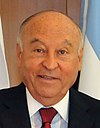List of political parties in Gapolania: Difference between revisions
No edit summary |
|||
| Line 61: | Line 61: | ||
| | | | ||
*{{wp|Centrism}} | *{{wp|Centrism}} | ||
*{{wp|Centre- | *{{wp|Centre-left politics}} | ||
*{{wp|Liberal conservatism}} | *{{wp|Liberal conservatism}} | ||
|- | |- | ||
| colspan="5" | Tommorow was founded in 1978 as answer of urban middle-class to a rising economic instability. They played a major role in organizing and leading the protests in 1981, coming second in the general elections in that year. Cipriano Piccio leads the party since 2007, shifting it from radical center to more centre- | | colspan="5" | Tommorow was founded in 1978 as answer of urban middle-class to a rising economic instability. They played a major role in organizing and leading the protests in 1981, coming second in the general elections in that year. Cipriano Piccio leads the party since 2007, shifting it from radical center to more centre-left politics, with the party especially known for its' anticlericalism. Their main support comes from bigger cities. | ||
|- | |- | ||
| rowspan="2" style="background: #dd4500;" | | | rowspan="2" style="background: #dd4500;" | | ||
Revision as of 13:05, 9 December 2020
There are 72 registered political parties in Gapolania. Gapolanese multi party government consists only of one house - the Senate, with 155 seats. Elections take place every 4 years and are general elections, with not only Senate representatives, but also the President being chosen. Gapolnia uses D'Hondt method when counting ballots, distributing seats to parties that gained at least 5% of all registered valid votes.
As of 2020, there are 12 parties with at least 1 representative in the national or local government. Six parties have their representatives in both the Senate and the local governments, while further six are represented only in the local governments. Here is the list of all represented parties (following the general elections in 2017).
List of parties
Parties in the Senate
| Party logo | Party name | Leader | Seats in the Senate | Ideology | |
|---|---|---|---|---|---|

|
Supportist Party of Gapolania Partito Supporto della Gapolania Gapolanijska Podrška Stranka |
 Ivano Cerbone |
51 / 155
|
||
| The Supportist Party of Gapolania was formed in 1934, following the revolution of Dušan Oseja, responsible for the fall of Soleggiato Regime in the republic. The party had been continuously ruling in the country until 1981, when Nikola Oseja was forced to step down as a result of large-scale protests. The party was banned from starting in the 1981 elections, however it underwent significant reforms and, since 1996, is led by Ivano Cerbone. Supportists won in 2001, 2009 and 2017 general elections. Their politics are mostly described as right-wing populism, with strong focus on middle-class and workers' unions. | |||||

|
Blue Hibiscus Ibisco Blu Plavi Hibiskus |
 Marcelo Segantù |
28 / 155
|
||
| Blue Hibiscus was formed in 1980, as a coalition of several democratic parties. Despite its initial success, Blue Hibiscus suffered several divisions and breakaways. The party won the elections in 1989 and later in 2013, with Marcelo Segantù being the party's president since 2009. Blue Hibiscus presents a wide array of political views, historically described as centre-left but since Segantù's presidenture it shifted more towards centre-right. It's especially known for its attachment to Sotirianity and the church. | |||||

|
Freedom La Libertà Sloboda |
 Elisa Perannazu |
27 / 155
|
||
| Freedom party was founded in 1973 and was particularly known for its strong liberal alignment. The party reached the Senate in 2001 and pushed for many reforms, especially these concerning ethnic, religious and sexual minorities. It also supported the legalization of cannabis and the civil partnerships between people of same sex. Before 2015, the party was led by Alessandro Vidžimović. The current leader is Elisa Perannazu, also known as they youngest president of any political party in the history of Gapolania. La Libertà' is mostly supported by younger people, as well as by women and ethnic minorities. | |||||
| Union of Gapolanese Conservatives Unione dei Conservatore Gapolani Koalicija Gapolanskih Konzervativaca |
 Martin Erceg |
18 / 155
|
|||
| UDGC's background can be traced back to 1940s, when the party was the most notable opposition of the Supportist party. It was formed by several minor conservative parties, strongly opposing populism and workers' unions. They're present in the Senate continuously since 1950, however the Union never won any elections. Their politics are strongly right-wing, especially when it comes to social issues. UDGC members support strictly organized hierarchical state, traditional social models and fiscal conservatism. The party is mostly supported by smaller towns, as well as rural populations. | |||||

|
Tommorow Domani Sutra |
 Cipriano Piccio |
17 / 155
|
||
| Tommorow was founded in 1978 as answer of urban middle-class to a rising economic instability. They played a major role in organizing and leading the protests in 1981, coming second in the general elections in that year. Cipriano Piccio leads the party since 2007, shifting it from radical center to more centre-left politics, with the party especially known for its' anticlericalism. Their main support comes from bigger cities. | |||||

|
People's Front Fronte Popolare Narodni Front |
 Lucian Emmanuel Caròn |
14 / 155
|
||
| People's Front is one of the oldest parties in Gapolania, founded in 1902 by land owners worried about state's negligence of the agriculture and rural population. The party was banned during the regime of Lorenzo Castiglione and thus it's revival after the Great War was largely applauded by the farmers and land owners, especially with the government's focus on industry. People's Front was often targeted by Osejan propaganda and only reached the Senate in 1981. Since then, it's continuously present in the government, often forming opposition. Led by Lucian Emmanuel Caròn since 1995, People's Front is Gapolania's main agrarian party. | |||||
Parties in the local governments
| Party logo | Party name | Leader | Governorates | Communes | Ideology | |
|---|---|---|---|---|---|---|

|
Red Umbrella Umbrello Rosso Crveni Kišobran |
Battista Bernardi | 10 / 12
|
183 / 241
|
||
| Red Umbrella was founded in 2012 by Battista Bernardi, an advocate of women's rights and a lawyer of sexual assault victims. It strongly promotes socialism, welfare state, atheism and feminism. Currently, there are no representatives in the Senate, however Red Umbrella members are present in 10 out of 12 governorates, as well as over three quarters of communes. Strongly supported by women and young people. | ||||||

|
National Movement of Conservatives Movimento Nazionale dei Conservatori Nacionalni Pokret Konzervativaca |
Milan Borović | 10 / 12
|
158 / 241
|
||
| Breakaway political movement that diverged from UDCG in early 2000s. The party is known for its strong anti-socialism and conservative views on a society. It opposed same-sex partnerships, legalization of cannabis for personal use, abortion of socioenomic reasons and re-nationalization of industries. Present in most governorates and communes, it's often supported by young men, as well as businessmen. | ||||||

|
Novalian Alliance Alleanza Novaliana Novalijanski Sovez |
Velimir Batko | 4 / 12
|
53 / 241
|
||
| Novalian Alliance was founded in 1920, during the Soleggiato Regime, in which Novalian and Carinthian minorities were largely discriminated in favor of the Vespasians and Vespasian descendants. Supported mostly by the Novalian and Carinthian-speaking minorities, it advocates for equal rights on social and economic fields. The party was part of Oseja's government and worked with him to recognize Novalian language as official in Gapolania. After 1981, its popularity lessened, however its representatives are still present in the regions, where Novalian o Carinthian populations are most prevalent. The Alliance is generally considered as conservative, though its politics tend to differ over time, dependent on the current issues of the ethnic minorities. | ||||||
| Greens Verdi Zeleni |
Michele Auragò | 2 / 12
|
34 / 241
|
|||
| Greens of Gapolania formed in 2007, an act of rebellion against the global climate changes. It encourages environmentalism, promotes responsible resource use and social reforms, that would create peaceful and equal nation. Present in two of the governorates, the party is finds support in urban populations, especially women. | ||||||

|
Charra | Fernando Pasiderrè | 1 / 12
|
11 / 241
|
||
| Charra, meaning "brave", is a party created by Jimoka people, indigenous groups of Gapolania. It strives for Jimoka rights, linguistic recognition, filling the economic gap and protection of both cultural and natural heritage of the country. It's represented in the governorate of Appalasta, as well as in 11 of communes there. | ||||||

|
Forward Andiamo Idemo |
Adriano di Berganza | 0 / 12
|
20 / 241
|
||
| Founded in 2014, Forward is a liberal party focused on support of globalization and cooperation between world states, minimization of state's power in favor of private property and wide usage of the Internet. The party strongly supports the digitalization of democracy and the state, as well as direct democracy. Its members' core principles are freedom, education and inclusiveness. The party is only represented on the commune level, in 8 districts of the capital domain and 12 communes of the Ellorio governorate. | ||||||